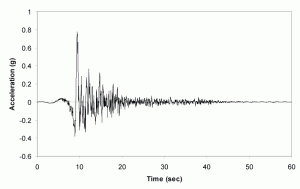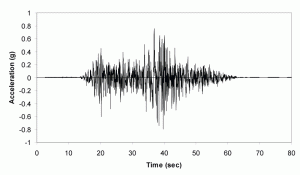What Does the Future Hold?
For most of us, our training as structural engineers has included significant attention toward transient seismic events. They can have such destructive potential as to occupy a major role in the geometry, design and detailing of our projects. For decades, prescriptive methods in codes have predicated design around a peak transient condition that presumably produces a peak base shear reaction and a peak rooftop displacement. These phenomena then become the basis of criteria for the seismic design.
These methods have arguably served us well, and ample evidence gathered in post-earthquake reconnaissance efforts suggests that structures designed and detailed in accordance with contemporary codes have a far greater potential for satisfactory performance than other structures. Even so, we are far from being able to state definitively that we can precisely characterize the nature of expected ground motions. As evidence of this concept, we need only consider changes in prescriptive earthquake design provisions that seem to follow in the wake of every major seismic event.
When considering the diversity that can occur among earthquake ground motions, we need not look any further than databases and ground motion suites commonly used for research and hypothetical studies. Consider two seismic acceleration records from the SAC Database derived for soft sites (Soil Type E), one delivering a peak ground acceleration (PGA) of 0.78g and the second a PGA of 0.80g. Based on these parameters alone and without actually looking at the accelerograms, we might conclude that these events should produce structural motions with comparable peak transient characteristics (drift and base shear).
As we examine such behaviors, this indeed seems to be the case, with these ground motions producing peak transient base shear reactions of 1,416 kips and 1,618 kips, respectively, on a prototypical shear wall structure. So if we subscribe to methods driven by current codes, we might conclude that these two events result in similar seismic demands on the structure. However, a closer look at the records as shown in Figures 1 and 2 might lead us to draw a different conclusion. While there are similarities in peak acceleration and frequency content, there are two major differences that are apparent.
- The first record has a slightly higher peak acceleration, but only has one pulse reaching a magnitude of nearly 0.8g. The second record has no fewer than six major pulses, all of which reach nearly 0.8g.
- The first record produces roughly 12 seconds of significant accelerations, while the corresponding duration for the second record is approximately twice as long.
The second record actually imposes a much higher overall demand on the structure than the first, primarily as an increase in element hysteretic cycles driven toward peak element displacements (or rotations). How can this demand be quantified in a practical sense? Ordinates from response spectra for these events produce similar accelerations, and response history analyses produce a similar result as we look at peak transient response. Clearly, conventional methods fall short.
Alternative analysis methods gaining favor in the research community include energy approaches. While many of these methods have been around for years, they have garnered greater attention recently in light of the Sendai Earthquake on March 11, 2011. Why is this so? The duration of this event was far longer than most others on record. Whereas earthquakes typically produce major shaking for 20, 30 or perhaps 40 seconds, Sendai continued shaking for minutes, leading many initially to doubt the validity of the recordings. It is clear that such events hold the potential for sustained lateral motion, and therefore an increased structural demand.
Researchers Park and Ang developed energy methods to address this issue. Their coupled approach accounts for peak transient response along with total energy demand, with energy capacity derived from hysteretic relationships not unlike nonlinear pushover curves. The Park/Ang approach is embodied in the equation:
where the first portion of the equation ([pmath]delta[/pmath]M/[pmath]delta[/pmath]u) represents peak transient displacement over maximum capable nonlinear displacement. The balance of the equation reflects the ratio of accumulated energy over maximum capable energy at maximum capable nonlinear displacement. This equation produces a scalar value not unlike a unity check. Results greater than 1.0 reflect structural failure, and results less than 0.4 reflect a structure that can likely be re-occupied immediately. Intermediate values reflect a structure that may be reasonably recovered.
Using this approach, it may not be surprising that results of the analysis for the previously mentioned test structure subjected to the two ground motions are significantly different. The first produces a damage index calculation (D) of 1.02, and the second a value of 16.2. This demonstrates that the structure would not survive the latter event, whereas the former is just over the failure threshold. In other words, the energy method shown here predicts that one earthquake creates a demand almost 16 times greater than the other … and this from two records of nearly equal peak ground accelerations.
Only time will tell what future codes may prescribe, and energy methods may eventually become mainstream. In the meantime, since current code methods do not address earthquake duration, what is the most prudent course of action? Do we now ask our geotechnical counterparts to address not only spectral accelerations and soil type, but also earthquake duration? Their fees (and likely their background) are probably not sufficient for that level of sophistication.
Under current codes, it is not practical or economical to address earthquake duration (among other ground motion characteristics) in our designs. Duration, like so many other aspects of future ground motions, is a great unknown. Trying to characterize it accurately is like trying to understand a city by taking pictures of the back yards of a few residents.
Rather, the more prudent approach is to pay careful attention to seismic detailing. Thoughtful detailing in accordance with current code prescriptions (which we should be doing anyway) can make a major difference with respect to the energy portion of the equation listed previously. Ductile detailing will increase the maximum capable nonlinear displacement, thereby raising the denominator in the latter half of the equation and lowering the calculated damage index. This translates to greater nonlinear displacement capability and a more resilient structure.▪
A similar article was published in the Structural Engineers Associations-Utah (SEAU) Monthly Newsletter (September, 2012). It is reprinted with permission.



